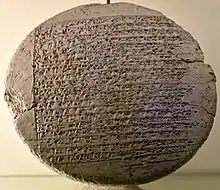Malgium
Malgium is a hitherto unidentified ancient Mesopotamian city now identified as Tell Yassir[1] which thrived especially in the Middle Bronze Age, ca. 2000 BC - 1600 BC.[2] Located on the river Tigris, south of where the Diyala River branches off and upstream of Maškan-šapir, it formed a small city-state in an area where the edges of the territories controlled by Larsa, Babylon and Elam converged.[3] Inscribed in cuneiform as ma-al-gi-imKI, its chief deities were Ea and Damkina.[4]:20

History

Three of its rulers have been identified with certainty, through attestation in their inscriptions as šàr (lugal) ma-al-gi-imki, Takil-ilissu, son of Ištaran-asû,[5] Imgur-Sin, son of Ili-abi, and, probably the last one, Ipiq-Ištar, son of Apil-Ilišu, a contemporary of Ḫammu-rāpi of Babylon, who celebrated conflict with the city in two of his year names (10 and 35). A further three rulers have been proposed, Šu-Kakka, Nabi-Enlil and Šu-Amurrum, three generations of a dynasty, based upon Šu-Kakka’s year name honoring the goddess Damkina. Their absolute position is uncertain but they seem to have reigned from the immediate aftermath of the downfall of the Ur III empire.[4]:19
The kings of Larsa targeted Malgium in their pursuit of territorial expansion with Gungunum celebrating its conquest in his 19th year name, circa 1914 BC,[4]:22 Sin-Iddinam its defeat in his 5th year name ca. 1844 and Warad-Sîn commemorated mu ugnim mà-al-gu-umki gištukul ba(-an)-sìg, “Year : the army? of Malgium was smitten by weapons”, ca. 1831 BC.[6] Ḫammu-rāpi, in a grand coalition with Shamshi-Adad I and Ibal-pi-El II (of Eshnunna), campaigned against the city-state until its ruler bought them off with 15 talents of silver. Freed from its vassalage to Elam, by Ḫammu-rāpi’s triumph over them, Malgium’s king, Ipiq-Ištar, concluded a treaty and subsequently provided aid and soldiers in Ḫammu-rāpi’s campaign against Larsa. For as yet uncertain reasons, Ḫammu-rāpi turned on his erstwhile ally and sacked the city ca. 1758, deporting much of its populace to Babylonia. Its state in the Middle Babylonian Period and later periods was much more humble as an administrative district called Malgu and a settlement referred to as Maliki.[3]
References
- Ahmed Ali Jawad, Barhan Abd Al-Reza, Ali Jabarat Nasir, Ahmed Abbas As’id, and Rients de Boer (2020). "The Discovery of the Location of Malgium (Tell Yassir)". Journal of Cuneiform Studies. American Schools of Oriental Research. 72: 65–86.CS1 maint: multiple names: authors list (link)
- Douglas Frayne (1990). Old Babylonian Period (2003-1595 BC): Early Periods, Volume 4 (RIM The Royal Inscriptions of Mesopotamia). University of Toronto Press. pp. 668–670.
- Trevor Bryce (2009). The Routledge Handbook of The Peoples and Places of Ancient Western Asia. Routledge. pp. 441–442.
- Rients de Boer (2013). "An Early Old Babylonian Archive from the Kingdom of Malgium?". Journal Asiatique. 301 (1): 19–25.
- Thorkild Jacobsen (1939). "The Inscription of Takil-ili-su of Malgium". Archiv für Orientforschung. 12: 364. JSTOR 41680358.
- Kathleen Abraham (2008). "New Evidence for Warad-Sîn's Mu-Malgium-Basig ('The Destruction of Malgium') Year Name". Revue d'Assyriologie et d'archéologie orientale. 102: 29. JSTOR 23281366.